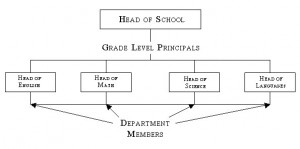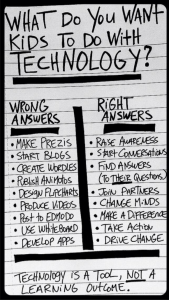Note: This blog post was written to help me understand how modern organizations are structured. It is in no way designed as a true academic article. In fact even though some of the questions raised do have answers to follow, I have much to learn about organization structure and how it affects an international school, either positively or negatively.
These days I have been thinking about how schools, especially medium to large sized schools are structured because there are severe consequences for international schools if their employees do not have a clear understanding of how the school works, including chaos, confusion, turf wars, and dysfunction. A clear organizational structure helps to staff properly, manage employees, and accomplish organizational goals. Paramount to this is an understanding of the chain of command the organization chooses.
Organizations today have many options for structure, including:
1) Tall Structures:
-
Departmental Structure – also called Functional Structure because responsibilities are divided based on different functions. In this type of organization different departments would fall under different managers. There would be an organization chart to clearly show the departmental structure, including titles and department names.
-
Divisional Structure – responsibilities are divided based on services and products provided by the organization. In this structure responsibilities that are common to each division (ex. marketing, HR and IT) are assigned to each.
-
Hierarchical Structure – this layered structure is useful when employees have assistants or subordinates.
2) Flat Structure – there are very few or no levels of management, and employees have significant input into how they do their jobs.
It is possible for organizations to develop a hybrid structure, also known as a matrix structure. Often this structure is chosen because the organization would like employees to have decision making ability, but also allow top management to maintain control. As a result the team aspects of a flat structure is combined with a functional hierarchy. When seen on paper the structure looks more like a matrix.
While a matrix structure can combine the strengths of both tall and flat structures, the functional result is employees will have more than one boss, the person who oversees the team (in a school’s case often this is a department head) and a top manager (in a school’s case the Principals or Head of School). This increases the risk of conflicts of interest within an organization.
However, conflict within an organization can have positive consequences if handled properly, possibly aiding the organization in moving forward to reach its goals. University of California Santa Cruz’s Social Science Researcher Betty Achinstein believes conflict “can no longer only be relegated to the domain of unprofessional or dysfunctional… To engage in conflict and question one’s beliefs with the possibility of deep change is fundamentally a positive and hopeful act rather than a problematic one within community” (Von Frank, 2012). If conflict is a risk resulting from a hybrid structure then an organization that seeks to avoid conflict should avoid this type of organizational structure. Hybrid organizations need strong leadership that can properly mediate conflict and keep employees pointed in the same direction.
But, what if a school does not understand its own organizational structure, calling itself flat when it really isn’t? International schools are often organized through a department structure, or at the very least a hybrid structure, though many teachers and administrators want to believe these organizations are flat structures. One reason for this, I believe, is that teaching is a fairly liberal profession where colleagues tend to treat each other informally and on an equal basis. As well, teachers may lord over their classrooms, but when they go into the staff room they are, despite specializing in different subjects, a group of individuals who have all received similar professional training and development, providing a certain amount of equality. In my experience in schools young teachers are treated as equals by the large majority of experienced teachers, adding to the atmosphere of equality.
When thinking about schools as flat organizations I have a number of questions:
What are the characteristics of a flat organization structure for schools?
According to BusinessDictionary.com a flat organization occurs when middle-management and their functions have been eliminated. As a result upper levels of management directly manage low level employees broadly across the organization. The concept of flat organizations is to remove hierarchies to allow for the lowest level possible to make decisions (Does a Flat Organization Have Negative Consequences?, May 15, 2012). Doing this would allow the people with specific knowledge and skills in an organization to make decisions quickly, thereby making the organization more efficient. In practice, for a school to be truly flat it would mean the elimination of middle management positions such as Heads of Departments, and perhaps even Principals depending on the size of the school.
What kinds of schools would benefit from a flat structure? Is this really the best approach in a medium to large organization such as an international school?
Smaller organizations such as startups are the ones who most commonly and successfully organize themselves this way because they can adapt quicker to changing business conditions. This suggests that medium to large sized schools that attempt a flat structure will not be successful and will actually result in the Head of the School or the School Administration members making all or most of the decisions. The problem with this is the size of the school and its demands mean these people are already too busy with their own responsibilities to micromanage each decision, and trying to do so only results in chaos and frustration.
Additionally, for many international schools the reality is they cannot take advantage of the ability to change quickly, even if they wanted to, for reasons beyond size of the school. The reasons for this include the host country’s bureaucracy, the conservative nature of many international schools or just simply needing time to bringing staff, teachers, students and parents on board and educate in a new way of doing things. The latter is more true for medium to large schools even if they have the best intention to change.
Is it possible for a medium to large sized school to truly benefit from a flat organizational structure?
Everyone having the power to move the organization forward through quick decision making sounds great for a school, right? However, flat organizations often do not achieve this goal of allowing specialized lower level employees to quickly make decisions. In his blog entry titled Does a Flat Organization Have Negative Consequences? Michael Roberto, a Trustee Professor of Management at Bryant University discusses Harvard Business School’s Julie Wulf’s study of data over a 15-year period of 300 U.S. firms that attempted to “flatten their hierarchies” by removing layers to improve performance. The results of her research suggest that this type of organization leads to a more centralized management structure, thereby negating the attempt to empower people and allow those with the skills and knowledge to make the proper decision. She says, “Results suggest that flattening transferred some decision rights from lower-level division managers to functional managers at the top. Flattening is also associated with increased CEO involvement with direct reports—the second level of top management—suggesting a more hands-on CEO at the pinnacle of the hierarchy.” This would be especially problematic for medium to large schools whose Administrators already have to manage so many tasks, or if the top of the school takes a hands off approach to decision making and communication.
What does a flat structure in a medium to large sized school mean for Administrators? Would this put too much pressure on them?
If the result of flattening an organization is to put more decision making in the hands of Administrators then the sheer number of people and decisions that need to be made in a medium to large size organization would make the structure ineffective. Administrators would find themselves juggling too many issues and problems and the result would be an ineffective organization where Administrators don’t have the time to properly connect the dots needed when administering a school. This risks creating a situation where you constantly have to put out fires rather than doing what school Administration should be spending their time on, creating and managing an efficient system and building school atmoshphere.
Additionally, top Administrators and decision makers may have many good skills and knowledge, both of the industry and of the institution, they cannot have complete knowledge of everything to fully take responsibility for every decision in a medium to large size school. They may do their best to collect all essential information, but the sheer number of decisions they would have to be intimately involved with would risk them having to cut corners by making decisions without first getting the full picture and gathering all the facts. This will put stress on others in the organization and lead to a weaker organization.
Does an organization have the support in place for people coming into the organization to understand this structure? Does the organization’s documentation reflect this?
In order for an organization to successfully implement a flat organizational structure how it is organized must be clear in documentation for people to understand. This is especially true for people coming into the organization because there is no guarantee that they are familiar with how this structure is effectively implemented.
In a Flat Structure there are only one or two layers of management supervising each department and ensuring it is aligned with the organization’s overall goals. A quick Google image search of flat organization structure shows the majority understanding of this type of organization to be organized this way:

Applying this to schools one could assume that the CEO is the Head and the Manager of Departments are Principals. However, considering that most medium to large schools often have at least one other layer of management in Department Heads, the actual structure of these schools might look like this:

Of course this is a simplified version of a school’s structure, but I think it illustrates the point that a school might have more layers to it than a typical flat structure. Comparing the two, some questions that immediately come to my mind is:
-
In the first diagram is the Manager of Departments the Principals or Department Heads?
-
Can a school that has an organizational structure like the second one truly be a flat organization?
-
In the second scenario, can aspects of a flat organization be incorporated? To do so what can be applied and what conditions need to be present in order to make it work well?
-
If a school has a structure like the second diagram, with four levels, but insists it is a flat organization, what is the effect on the mid-level Department Head layer? Does this result in the Department Heads not being empowered due to “flattening” their position? What then, is the role of the HOD?
On the last point, a school that is organized in a vertical structure but with leaders insisting it is a flat structure risks alienating employees such as at the HOD level. Giving people a title and responsibilities on paper but not actually empowering them to perform their duties in practice because they have been “flattened” could lead to frustration. Of course, it doesn’t have to be that way. If there is a true understanding of how the school works, and this is communicated well so all members understand how it works, it might be possible to have the Department Heads “flat” at various times with the people they are leading.
This brief blog entry is my attempt to understand how schools are structured and how the understanding, or lack of understanding, of the structure could affect the school and its employees. It is by no means a definitive answer. There is more I want to write about but it will have to wait for another entry. This one is getting too long as it is!
Some readings on organizational structures that I read to write this post include:






